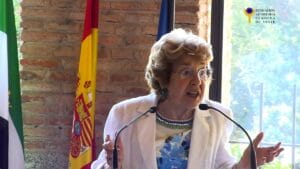An Italian, Corradi studied law in Rome, and then was awarded a Fulbright Scholarship to complete her Masters of Comparative Law degree at Columbia University in the United States. Yet upon returning to Italy, Sapienza University of Rome refused to recognize that degree. “At the student secretariat counter, the clerk fell from the clouds,” she remembered. “‘Columbia University? Never heard of it!’ And when the director arrived, he filled me with insults: ‘Do you think we give a degree to those who go for a picnic in the United States? Go back to study and see if you are promoted!’ I understood that day that the equalization of university degrees in the world, or at least in Europe, was something to be done.” It took her 8 months, but emerged with her Doctorate in Law. She turned down jobs in law firms determined to reform the Italian educational system. She took a job at the United Nations Commission on Human Rights, where she studied the concept of education being a fundamental human right.
As Corradi’s reputation grew, she was hired as a scientific advisor to the Association of Rectors of Italian Universities. As she gained contacts and reputation, she finally made her move. In 1969, she wrote a whitepaper outlining her idea for “Erasmus”. Named for Erasmus of Rotterdam, a Dutch philosopher who was one of the most influential scholars of the Northern Renaissance, as well as a major figure of Western culture, her idea was to create a formal system where students could easily move among universities across Europe and the world, and — of course! — those earned credits would apply toward their degrees at their home universities. As she put it in the whitepaper, “The student, even if not belonging to a family resident abroad, can ask to carry out part of his study plan at foreign universities, presenting it to the Faculty Council for approval in advance. The Faculty Council can declare the equivalence, which will become effective after the student has produced documentation of the studies completed abroad.”

Or, another way she put it years later: “Anger and humiliation: that’s the genesis of Erasmus. I promised myself that no other student would ever suffer an insult like the one I had suffered.” She had her paper made into a mimeograph master for easy reproduction, and spread it widely. Before the year was out, Mario Ferrari Aggradi, Italy’s Minister of Public Education, formalized Corradi’s ideas into a bill to reform Italian universities. The bill fought its way through the legislative process for more than three years before it died, but it had enough momentum that it jumped out of Italy and into the European Economic Commission, approved in February 1976 as experimental “Joint Study Programs” for the “mobility [of students] with recognition of credits” across all of the EEC countries. The “experiments” ran until 1986, at which time it was made a permanent program called Erasmus.
It was “18 years of battles,” Corradi said later, “of small and large defeats, during which I annoyed so many people. The only thing that survived was my memo, which continued to be used as a reference model.” An example of a fight: “When I explained my idea,” she said in 2016, “many asked me what the point was of sending students to Germany to chase blonde girls. I explained that in Italy they could chase brunettes, but that wasn’t the problem: if someone didn’t want to study, they wouldn’t take exams anyway. What mattered was that exams passed abroad were considered valid in Italy.” Since then, the program has been expanded even further: today, professors can also be mobile as guest lecturers at other universities. Around 16 million people have been part of Erasmus since its formal adoption in 1987. The program doesn’t just benefit students, but promotes closer cooperation between universities across Europe.
Meanwhile, Corradi taught Lifelong learning at the Faculty of Educational Sciences of the Roma Tre University from 1980 to 2004, and was often referred to as “Mamma Erasmus”. In 2016, she received the European Charles V Award from King Felipe VI of Spain and the president of the European Parliament, Martin Schulz. On that occasion Stefania Giannini, Minister of Education, thanked Corradi “for her extraordinary work. We owe her tenacity for a Program that has completely revolutionized the lives of our children, contributing to the construction of Europe.” Dr. Corradi died in Rome on October 18, at 91.
